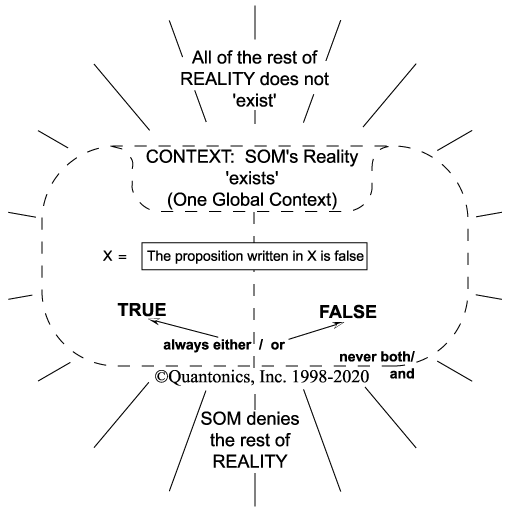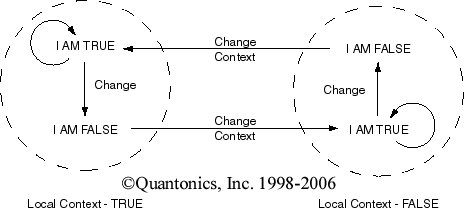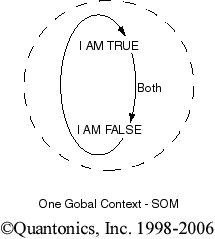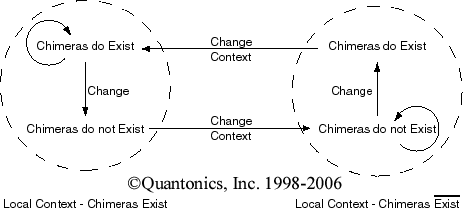Acronyms and symbols used in The SOM Connection:
| DQ | - Dynamic Quality (Pirsig) |
| OGC | - One Global Context (What is OGC?) |
| OGT | - One Global Truth (What is OGT?) |
| SOM | - Subject-Object Metaphysics |
The SOM Connection:
Right away, in Hughes' book, in his Introduction, on pages 23-7, Hughes shows SOM's legacy assumption of One Global Truth (OGT). Hughes shows it during his first discussion of a self-referent sophism which he depicts thus:
One larger point we wish to make about SOM reality in which Hughes and Buridan both appear mired, is SOM assumes One Global Context (OGC) for this sophism.
Before proceeding with this segment, allow your reviewer a moment to state our own local SOM definitions OGT and OGC:
| OGT - One Global Truth: What is OGT? |
By SOM dialectic, SOM reality composes that which exists. Reliable, either TRUE or FALSE, statements or propositions may be formed about real, separate, individuistic SOM objects which exist. We call this SOM 'fact,' OGT. |
| OGC - One Global Context: What is OGC? |
By SOM dialectic, that which is not 'in' SOM reality does not exist. We infer SOM's reality context is limited to that which exists. That which does not exist is, "out of context." Reliable, either TRUE or FALSE, statements or propositions may not be formed about that which does not exist. |
Having asserted our SOM points and definitions, we can show OGC is precisely the source of apparent paradox expressed by Hughes' exemplar sophism. To make our point more clearly, we prepared a graphic shown in Figure 1. In our graphic, we embed Hughes' sophism, proposition X, centrally in SOM's OGC, and attempt to interpret it according to SOM's OGT dialectic. Please study our graphic carefully, and see if your interpretation fits our subsequent comments:
 |
From Figure 1 above, you may infer, with imagination, several points of interest:
SOM's formal logic tells us several rules about propositions:
To make our lists as simple as possible to understand let us describe larger reality thus (note: our words below transmogrify our map of a new reality on this review's top page):
In our concise list above, we show larger reality as:
As we can see in our new reality list, SOM reality is a subset of a vastly larger reality. From your reviewer's perspective, Buridan, Hughes, et al., mostly reside in SOM reality, barely dipping their toes in an omniversal larger reality.
Now, Buridan, Hughes, et al., claim proposition X is a sophism.
Reviewer note: Greeks denigrated sophism and sophists as untrue, as liars, as threats to the truth. Plato and Aristotle hated sophists. Remember Pirsig teaches us sophists reigned for more than 10 millennia before Greeks rose to a Western fore of cultural correctness. Sophists believed in aretê. Aretê for sophists is excellence, honor, goodness, quality, etc. See The Birth of SOM. Sophists taught good was above truth, or as Phædrus loved it, rhetoric was above dialectic. Greeks taught truth was above good and truth depends upon SOM's OGT in OGC.
Indeed, within SOM's OGC, X appears paradoxical. But viewed from a perspective of larger reality SOM's X paradox dissolves. Rather than perceiving sophisms as semaphores of new reason, Greeks saw sophisms as untrue and nonexistent SOM paradoxes. They imposed an intellectual inquisition against sophists, and we live with this errant Greek edict today.
Thus, still today, most logicians and dialecticians like Hughes, Buridan, et al., say X is a proposition bounded by SOM reality. They worry sophisms cause great pain to SOM's revered dialectic and formal logic. Why? Because sophisms like proposition X appear paradoxical in SOM. They still claim proposition X is a paradox.
Why is X a paradox in SOM reality?
Because:
Buridan 'proves' sophisms are FALSE! Buridan tells us anything which claims similitude of truth and falsity is "absurd." Now gentle reader, allow your reviewer a caveat: Whenever you hear words "absurd," or "unreasonable," be assured you are near presence of a SOMite! Be assured you are near presence of a being of limited context truth. Be assured your colleague is in Pirsig's well-described prison of classical reason. Your colleague is in SOM's prison of OGT and OGC. Your colleague is in Pirsig's classical SOM, "Church of Reason."
In a larger quantum reality words "absurd," and "unreasonable," disclose constrained logic and reason of those blinded by their imprisonment in SOM's Church of Reason. Larger quantum reality is a reality of many truths and many contexts. SOMites deny this reality. In so doing, they install their own personal blinders. Those blinders are responsible for appellations "absurd," and "unreasonable."
We can demonstrate, rather simply, a new high Chautauqua of reason traveling above SOM's dialectic swamp. Let us take our Chautauqua and visit a new way of thinking. Before we take our first step, let us expand on Pirsig's prime (anti-)dialectic axiom which we say as, "There are many truths."
Let us expand our prime axiom thus:
Reader, be aware our list is partial. We show only those axioms necessary to proceed with our discussion here. Also be aware, contexts referenced in our axioms above are more general than what we were taught about SOMland. Our new contexts are infinite-dimensional and omnicontextual. Our new contexts cohere (yes, co-here) Pirsig's DQ (quantum dual of DQ is quantum flux).
Let us make a preliminary bridge step as shown in Figure 2, below:
 |
Figure 2 uses a simple case of two contexts to illustrate graphically a meme of many truths. Our graph shows a special case of only two truths. But only two truths are adequate to demonstrate truth is not global. Words TRUE and FALSE in each context are assessed locally. We contrived these two contexts as logical inversions of one another. "I AM TRUE" in one context is inverse of "I AM TRUE" in another context. Ditto for "I AM FALSE" propositions. We allow for spontaneous change of context when a proposition's truth or falsity inverts. As long as a proposition is TRUE in a local context, a proposition remains in its current local context.
Note Figure 2 still retains bivalent truth value. In either of our contrived contexts truth value is SOMlike, either TRUE or FALSE. In a more general reality of many truths and many contexts we find not bivalence, but omnivalence of stochastic expected value for truth and falsity. We find for a given proposition an uncertainty relation exists between TRUE and FALSE. Why? Because our omnicontexts must obey quantum reality. Omnicontexts are no longer a SOM OGC. SOM's OGC is ideally measurable, isolable, separable, individuistic, etc. Quantum contexts (see comtext; quantum 'contexts' are 'comtexts;' also see con-) entangle, interpenetrate, commingle, and cohere.
Note how we solved his sophism which Buridan declared, "false." We did it by allowing more than one context and more than one local truth convention. From your reviewer's perspective, Figure 2 validates Pirsig's call for many truths. Note too, in a larger reality there are, not just two truth conventions, but an infinity
When we compare what happens in Figure 2 to Buridan's same proposition shown in a Figure 3 SOM version, we begin to see bright light of a new reason dawning:
 |
Figure 3 shows a sophism stuck in SOM's OGT-OGC. The result is a mind-numbing whir of endless alternations of TRUE/FALSE in a single context. Here we see graphically the major dialectic fault in SOM. SOM, by its own dogma cripples its own capability to solve sophisms. Inventors of SOM used this incapability to denigrate Sophism and Sophists.
In his work, Hughes repeatedly claims chimeras, "...do not exist." Of course, today we know they do exist. We provide ample evidence. See Are Chimeras Real? Our point is SOM dialecticians like Hughes, Buridan, et al., use a presumed absence of existing substantial reality to declare some propositions, "FALSE." They assume because no evidence for insubstantial reality exists, things unknown to SOM reality do not exist.
We want to change Figure 2 so it uses existence of chimeras as means to establish local contexts. Regardless whether chimeras exist, logic still holds when we use multiple local contexts:
 |
Here we see both chimeras do exist and chimeras do not exist as local contexts. If we choose SOMthink as our tool of reason, we have to choose, dichotomously, one or another context in which to reside. From a perspective of context: chimeras do not exist, existence of chimeras is absurd. From a perspective of context: chimeras do exist, nonexistence of chimeras is absurd. From a larger reality perspective of many truths, we claim there are many contexts, and in some contexts chimeras exist, in others chimeras do not exist, and in still others chimeras both do and do not exist (we have not illustrated the latter - it is a simple 3D triad of three contexts with local truth loops and vectors of change from one context to another).
Clearly an assumption of absolute OGT truth burdens SOM language. It stilts innovation. It stilts comprehensive thinking and reason. Yet, every day we hear our friends, pundits, teachers, and dialecticians say, "...the truth..." E.g., "If they would just tell the truth." Or, "The truth will come out eventually."
We call this nexus, i.e., a the-one truth nexus 'thelogos.' Sentients who use 'the' to form omnipotent statements, e.g., "...the whatever..." with emphasis on 'the' as one or only or wholly unique, we call thelogosists. Take a look at our June 1999 Quantonic Q&A for more on thelogosis.
Once you discover this pattern in SOM language, it becomes a dented fender. You cannot rest until you fix SOM's dent. In your reviewer's opinion, Pirsig fixed SOM's dent, but did it subtly, and many of his readers failed to grasp enormous ramifications of his fix. He focused our attentions on platypi, puzzles, and Mu, but he treaded lightly some most fundamental issues of SOM—its assumptions about our following list's semantics:
SOM philosophy places a terrible burden on logicians. Splitting subject and object from each other and then correlating things of mind as subjective (unreal) and things of body as substantial (real) imposes unlimited paradice (paradoxes) on SOMthink. Logicians and rhetoricians who accept SOM's split relegate their bountiful works to a heap of Babelian refuse. We see an example here in Hughes' review of chapter eight of Buridan's Sophismata. Buridan shows glimmers of breaking SOM's chains, but pretty much stays with his Aristotelian/Platonic dialectic inquisition legacy.
SOM's paradice, especially its self-referent paradice, fascinate Buridan and his medieval peers. For them it is mental candy. But their tools are Aristotelian, classical.
Classical logic adheres an Aristotelian edict: substance exists and non-substance does not. Therefore, propositions in classical formal logic must rigidly connect in some linguistic or mental way back to things substantial, existent things, so formal logic can produce the truth. Thus, propositions which connect to insubstantial stuff are false. Propositions which logically connect to substantial stuff can (are capable to) determine absolutely a true or false result from any SOM proposition. (See Bergson's "Negation is subjective.")
Now when you think about this, you see a dramatic and unfortunate result: all classical formal propositions are limited to an anthropocentric known, to what Earth chauvinists perceive exists! SOMthink and its abysmally inept dialectic logic distill to opinion! They distill to tentative judgment. SOM's laws are essentially naught more than judgment and opinion! But, arrogantly, SOMite truepers insist they can assess and know absolute, universal truth! Now can you see why we say SOMthink has blinders? SOM denies any unknown, implicitly. That is how SOM can conclude a determinate future! (In Lila, Pirsig called this a SOM platypus. He showed us how classical science is incapable of classifying the new. His example was a platypus.)
Return to Hughes-Buridan Book Review
Notes:
Expected Value - Here we mean expected value in a relative statistical sense, different from SOM's assumed absolute, bivalent TRUE/FALSE truth values. In a more general reality truth is relative: